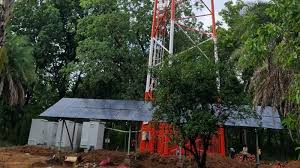Maoist-hit Bijapur gets closer to mainstream, one mobile tower at a time

Bijapur district, nestled in the Bastar region of southern Chhattisgarh, has long been known for its dense forests, tribal communities, and the persistent threat of Maoist insurgency. For decades, development remained a distant promise. Roads were unpaved, schools struggled to function, and mobile phones were practically useless due to lack of connectivity. But change is slowly, yet steadily, ringing in—quite literally.
In a region where Maoists once dictated the daily rhythms of life, the gentle hum of construction equipment and the blinking lights of newly installed mobile towers are signaling a new chapter. Remote villages, once invisible to the outside world, are now getting their first taste of digital connectivity.
A Tower of Transformation
Until recently, most of Bijapur’s forest-bound villages were cut off not only physically but also digitally. With little to no mobile coverage, communication was confined to word-of-mouth or occasional trips to distant towns. Emergency services were nearly inaccessible, and information from government welfare schemes seldom reached those who needed it most.
The government’s effort to expand telecom infrastructure, even in high-risk zones, is changing that narrative. Under the Universal Service Obligation Fund (USOF), several mobile towers have been installed across Bijapur’s vulnerable and previously ignored areas. These towers, built with heavy security arrangements and advanced solar-powered systems, are bringing the modern world closer to communities that had long been forgotten.
Security Challenges and Strategic Planning
Installing mobile towers in Maoist-dominated regions is no small feat. Maoist groups have frequently targeted communication infrastructure, viewing it as a symbol of state presence. To mitigate these threats, security forces are working hand-in-hand with civil authorities and telecom companies.
Each tower installation is preceded by intelligence assessments and military coordination. The Central Reserve Police Force (CRPF) often provides security cordons during construction, ensuring workers are protected. In many cases, the towers are built in camps already secured by security forces, gradually expanding coverage outward to nearby villages.
Despite occasional threats and sporadic attacks, the plan continues to move forward, driven by the firm belief that development is the antidote to insurgency.
Connecting the Unconnected
The impact on the ground is palpable. In villages like Gangaloor, Madded, and Bhairamgarh, locals are now able to make phone calls, access digital payments, and receive updates on government schemes. Youths who once had to walk kilometers to find network signals can now browse the internet in their own homes.
Farmers are learning about weather forecasts and market rates through smartphone apps. Students, for the first time, can join online classes and benefit from educational videos. For women, especially, the mobile revolution has created a sense of empowerment. They can now connect with healthcare providers, seek information about their rights, and even lodge complaints if needed.
Bridging the Development Gap
Connectivity is a fundamental enabler of development. The mobile towers in Bijapur are not just about phone calls—they are about inclusion. With better access to information and communication tools, villagers are becoming more aware of their entitlements under government schemes such as the Pradhan Mantri Awas Yojana (PMAY), PM-KISAN, and various tribal welfare programs.
Digital connectivity also supports governance. Local officials can now coordinate disaster relief, monitor schemes in real-time, and collect data from remote habitations without delay. e-Governance kiosks, digital banking, and mobile-based health services are all becoming feasible in areas that were once inaccessible.
Youth at the Forefront of Change
Perhaps the most enthusiastic adopters of this digital transformation are Bijapur’s youth. Many of them have grown up amid conflict, but with a mobile signal comes aspiration. Young people are exploring online learning platforms, applying for jobs, and even becoming local influencers.
Several startups and NGOs have started engaging with the region’s youth, offering digital literacy programs and career guidance through mobile apps. In a landscape once dominated by despair and violence, dreams are taking root.
The Road Ahead
The process of integrating Maoist-affected regions like Bijapur into the national mainstream is slow but visible. While challenges persist—including sporadic violence, mistrust, and logistical hurdles—the success of mobile connectivity projects offers a blueprint for future efforts.
Government officials stress that development and security must go hand-in-hand. As more towers come up and more villages get connected, the cycle of isolation that once fed extremism is being broken.
Bijapur’s journey is far from over, but each mobile tower that lights up in the forest is a beacon of hope. It symbolizes not just connectivity, but dignity, opportunity, and a stake in the future.






